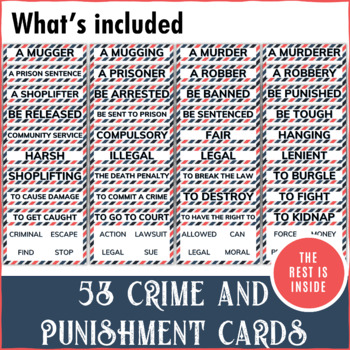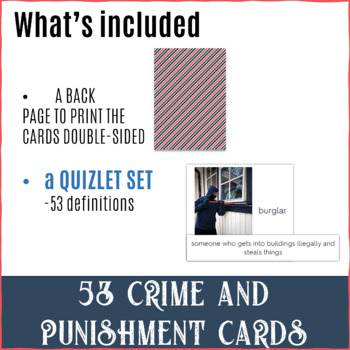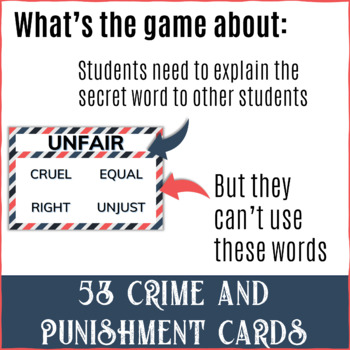CRIME AND PUNISHMENT guessing game for ESL students
- Zip
Description
Teach Crime and Punishment Vocabulary with Engaging Taboo Cards and Quizlet Set!
Calling all English as a Second Language (ESL) educators! Elevate your classroom experience and help your intermediate-level students expand their crime and punishment vocabulary with this dynamic set of taboo cards. This resource is also ideal for creating a fun and interactive learning environment.
Key Advantages of Crime and Punishment Taboo Cards:
- Boost Confidence: Build your students' confidence in using crime and punishment-related vocabulary.
- Word Association: Strengthen word-to-meaning connections.
- Effective Review: Reinforce students' understanding of crime and punishment terminology.
- Vocabulary Reactivation: Revitalize and consolidate previously learned vocabulary.
- Promote Free Expression: Encourage students to express themselves creatively and confidently.
- Enhance Communication and Vocabulary Skills: Improve your students' overall language skills and deepen their crime and punishment vocabulary.
High-Quality Taboo Cards:
- The set includes 53 taboo cards, meticulously designed and presented at a high-quality standard.
- A back graphic page is provided for easy double-sided printing.
- All cards feature clear visuals and legible text.
- Each card contains a set of four taboo words, providing a challenging and engaging experience for your students.
Comprehensive Vocabulary Set:
This resource covers a wide range of crime and punishment vocabulary, ensuring a comprehensive exploration of the topic. Here's a glimpse of the words included:
- Burglar
- Criminal
- Kidnapper
- Murderer
- Robber
- Shoplifter
- Sentenced
- Community service
- Legal
- The death penalty
- Be arrested
- Harsh
- To burgle
- To vandalize
- To surrender
- And much more!
Versatile and Engaging Learning Resource:
- Suitable for intermediate-level ESL students.
- Supports vocabulary development and overall language skills.
- Encourages critical thinking and explanation abilities.
- Can be integrated into various classroom activities, including vocabulary practice, discussions, and review sessions.
Interactive Quizlet Set:
- This resource includes a PDF file with a link to a Quizlet set, adding an interactive and digital component to your lessons.
- Utilize Quizlet for engaging vocabulary drills, quizzes, and interactive vocabulary-building exercises.
Elevate Your ESL Classroom:
Enhance your ESL classroom with this set of taboo cards, specifically designed to teach crime and punishment vocabulary to intermediate-level students. These cards offer an exciting way to engage your students, reinforce language skills, and create a dynamic learning environment.
Whether you're introducing crime and punishment vocabulary for the first time or reviewing previously learned terms, these taboo cards will add a fun and interactive dimension to your ESL lessons.
Don't miss the opportunity to make ESL learning engaging and effective. Incorporate these taboo cards and the Quizlet set into your teaching resources, and watch your students excel as they explore the world of crime and punishment vocabulary!





